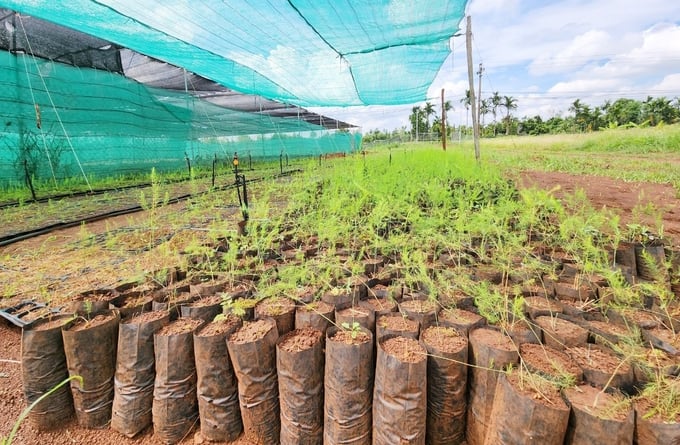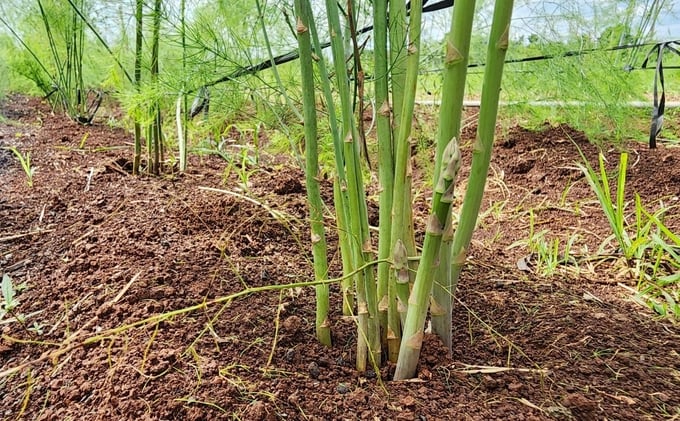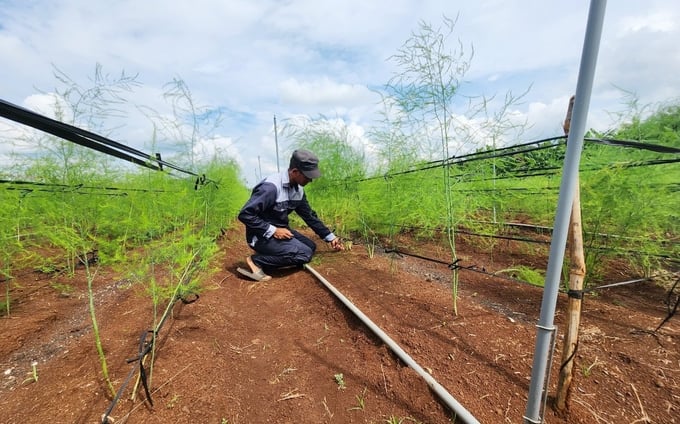November 26, 2025 | 12:53 GMT +7
November 26, 2025 | 12:53 GMT +7
Hotline: 0913.378.918
November 26, 2025 | 12:53 GMT +7
Hotline: 0913.378.918

Asparagus varieties are imported from the U.S. according to the climate and soil conditions in the Central Highlands, so they are resistant to diseases and have high product quality. Photo: Minh Quy.
Mr. Huynh Thieu Dung, Director of the Central Highlands region of Ngoc Minh Chau High-tech Agricultural Cooperative (Cu M'gar district), said that the unit has just sent a document to the communes and the Department of Agriculture and Rural Development of Cu M'gar district to Proposal to support the expansion of sustainable green asparagus production and consumption models.
Previously, Ngoc Minh Chau Cooperative built a trial garden of 1,000 square meters of green asparagus and a 720 square meter nursery, cultivating more than 132 thousand seedlings. After the pilot implementation period, up to now, green asparagus has grown, on average, more than 1 meter tall. The plants are big and robust and have begun to produce shoots. Young trees grow well for nurseries, are healthy, and are free from fungal diseases.
According to Mr. Huynh Thieu Dung, the cooperative imported seedlings directly from the US when implementing the model. This is the green asparagus variety UC157 with guaranteed quality, ordered according to the general temperature range of the Vietnamese market.
When implementing the association model, Ngoc Minh Chau Cooperative will focus on addressing 4 basic factors to ensure sustainable success for farmers. Specifically, the cooperative provides 100% seed. After having products, the unit will gradually recover capital to reduce initial costs for farmers because investment in seedlings accounts for 70 - 80% of the total initial investment cost of the company. People wait for 4 months to harvest.
The remaining costs, such as irrigation systems and fertilizers, are less than VND 5 million/ha, so for each hectare, farmers only have to make an initial investment of less than VND 50 million within 4 months. This will help reduce investment for farmers. By the 5th month, asparagus will begin to be harvested.
When collaborating, Ngoc Minh Chau Cooperative guides the entire farming process to ensure farmers achieve productivity and quality products. The cooperative will sign a contract to sell all products to farmers within 5 years at a stable VND 35,000/kg price.

Green asparagus is produced using organic processes. This crop has much development potential in Dak Lak and the Central Highlands. Photo: Minh Quy.
It only takes 3 months for people to recover their initial investment. In the remaining months, people harvest and earn a net profit.
According to Mr. Huynh Thieu Dung, through surveys and practical implementation, conditions such as soil quality and climate of the Central Highlands are very suitable for growing green asparagus. Specifically, the soil here is basalt red, sandy gray, and chicken fat, which is very suitable for growing asparagus. In addition, the Central Highlands has a high terrain, so there is little flooding, and the temperature amplitude is at 18 - 39 degrees Celsius, so it is suitable for green asparagus to grow and help improve quality. In particular, the workforce in the Central Highlands is abundant, so it can meet the requirements when deploying in a large area.
According to Mr. Huynh Thieu Dung, the entire process of growing green asparagus in the cooperative follows organic standards. Accordingly, growers must use biological products organic fertilizers, not chemical fertilizers, pesticides, herbicides... From preparing the land to planting, the cooperative's engineers Only use rice husks, cow manure, probiotic powder, and microbial organic fertilizer (composted for three months or more) and apply to the beds for planting.
For the care stage, from seedling to harvest, usually every 15 to 20 days, fertilizer will be applied (worm solution mixed with fish protein compost microbial fertilizer), and biological products will be sprayed to prevent pests. After 3 months of harvesting, the soil will be loosened to add compost, and the plants will rest for one month to recover.
After many trials of growing green asparagus organically, the cooperative found that the yield was still satisfactory compared to production using conventional methods. In particular, growing green asparagus organically will give better quality.

Ngoc Minh Chau Cooperative will provide farmers with technical guidance and product sales when collaborating to grow asparagus. Photo: Minh Quy.
Mr. Bui Thuc Nhuong (living in Quang Hiep commune, Cu M'gar district) is one of the pioneering families associated with Ngoc Minh Chau Cooperative to test asparagus in Dak Lak. According to Mr. Nhuong, asparagus grew well after 40 days of trial planting. When planting, only use organic fertilizers and biological products so you can rest assured about your health.
Mr. Nguyen Ngoc Giao, Head of the Department of Agriculture and Rural Development of Cu M'gar district, said that the locality has received a written proposal to expand the green asparagus growing area of Ngoc Minh Chau Cooperative. In the coming time, the Department of Agriculture and Rural Development will advise the District People's Committee to create conditions for this unit to deploy.
According to Mr. Giao, when Ngoc Minh Chau Cooperative brought asparagus varieties to the locality for trial planting, it helped restructure local agriculture. This new crop with high economic value is grown organically and will be stable and sustainable.
Ngoc Minh Chau Cooperative will provide technical guidance, planting, and care supervision when collaborating to grow asparagus. Each hectare of asparagus will grow 20,000 - 22,000 seedlings, yielding 40 tons/year. The life cycle of asparagus is 3 - 5 years, depending on care conditions. Asparagus will be harvested in the 5th month after planting. Harvest every 3 months and take a month off.
Translated by Tuan Huy
/2025/11/26/3627-4-082628_818.jpg)
(VAN) From a small café on the red basalt highlands, Le Van Hoang started a business with clean coffee, building Enjoi Coffee into a symbol of organic agriculture in the Lam Dong plateau.
/2025/11/25/0045-1-135246_13.jpg)
(VAN) Ca Mau is researching a model of sea-encroaching embankments combined with viaducts and logistics service zones, aiming both to prevent erosion and create land funds for marine economic development.

(VAN) The information was shared at the seminar 'Urban Agriculture - Solutions for Developing Green Spaces,' organized by the Kinh te & Do thi Newspaper and the Biotechnology Center of Ho Chi Minh City.
/2025/11/19/4141-2-132831_216.jpg)
(VAN) One of Japfa's outstanding solutions is implementing digital transformation and artificial intelligence (AI) to optimize operations, enhance productivity, and advance sustainable development.
/2025/11/19/4847-1-093540_448.jpg)
(VAN) The Gia Lai Provincial People’s Committee had a working session with the delegation of the U.S. Department of Agriculture, the State of Idaho, and representatives of the State's leading enterprises.

(VAN) Ca Mau has a sufficient foundation to become a strong regional aquaculture center, where production integrates the economy, the environment, and the lives of the people.

(VAN) SEIKI Group envisions itself as a pioneer in the ‘dual transformation’ of digital technology and green industry, standing alongside the Government and Vietnamese businesses in their pursuit of sustainable development.